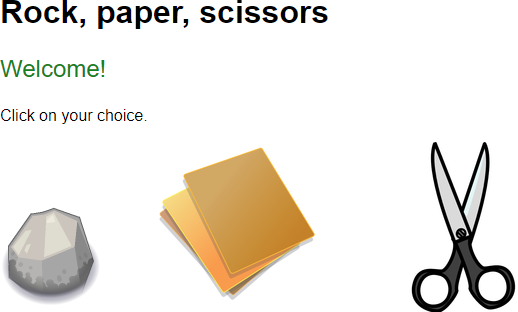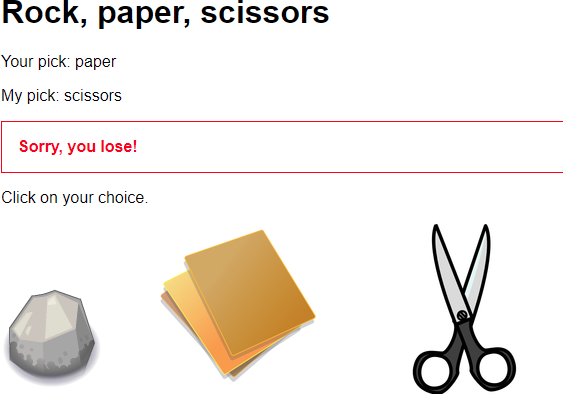Let's make a rock-paper-scissors game, where the computer always wins. You can try it
The program uses the GET parameter pick to get the user's choice. If pick isn't there...
rock-paper-scissors.php
... the program prints a welcome message:

If there's a user pick...
rock-paper-scissors.php?pick=paper
... the program shows the user's pick, and one of its own. Thing is, it always wins.

Making a choice
Here's the first part of the program:
- <?php
- $userPick = null;
- $computerPick = null;
- if (isset($_GET['pick'])) {
- $userPick = $_GET['pick'];
- if ($userPick == 'rock') {
- $computerPick = 'paper';
- }
- if ($userPick == 'paper') {
- $computerPick = 'scissors';
- }
- if ($userPick == 'scissors') {
- $computerPick = 'rock';
- }
- }
- ?>
The variables $userPick and $computerPick record the user's and computer's pick. They start off as null. That's how the program will know whether it needs to output the welcome text.
If there is a value for pick (line 4), the code grabs it, and puts it into $userPick (line 5). Then it makes its own choice. It will take whatever beats the user.
Showing the results
The rest of the program tells the user what happened.
- <h1>Rock, paper, scissors</h1>
- <?php
- if ($userPick == null) {
- print "<p class='welcome'>Welcome!</p>";
- }
- else
- {
- print "<p>Your pick: $userPick</p>\n";
- print "<p>My pick: $computerPick</p>\n";
- print "<p class='lose'>Sorry, you lose!</p>\n";
- }
- ?>
- <p>Click on your choice.</p>
- <p>
- <a class="pick" href="rock-paper-scissors.php?pick=rock">
- <img src="rock.png" alt="Rock">
- </a>
- <a class="pick" href="rock-paper-scissors.php?pick=paper">
- <img src="papers.png" alt="Paper">
- </a>
- <a class="pick" href="rock-paper-scissors.php?pick=scissors">
- <img src="scissors.png" alt="Scissors">
- </a>
- </p>
First, the code decides whether to show the welcome message. It will do that if $userPick is MT.
- if ($userPick == null) {
- print "<p class='welcome'>Welcome!</p>";
- }
- else
- {
If $userPick isn't null, then the program shows the two picks, and who won:
- print "<p>Your pick: $userPick</p>\n";
- print "<p>My pick: $computerPick</p>\n";
- print "<p class='lose'>Sorry, you lose!</p>\n";
There's no need for an if to detect who won. The computer always wins.
Finally, the program shows the three choices, for the next game:
- <p>Click on your choice.</p>
- <p>
- <a class="pick" href="rock-paper-scissors.php?pick=rock">
- <img src="rock.png" alt="Rock">
- </a>
- <a class="pick" href="rock-paper-scissors.php?pick=paper">
- <img src="papers.png" alt="Paper">
- </a>
- <a class="pick" href="rock-paper-scissors.php?pick=scissors">
- <img src="scissors.png" alt="Scissors">
- </a>
- </p>
Notice the hrefs for the links. The value of the pick that matches the image is at the end of the URL.
Easy peasy
That's it! See how easy it is for a computer to cheat? We could make it less obvious, by cheating on, say, one game in four.
Yeah, online gambling's legit, right? What could possibly go wrong?